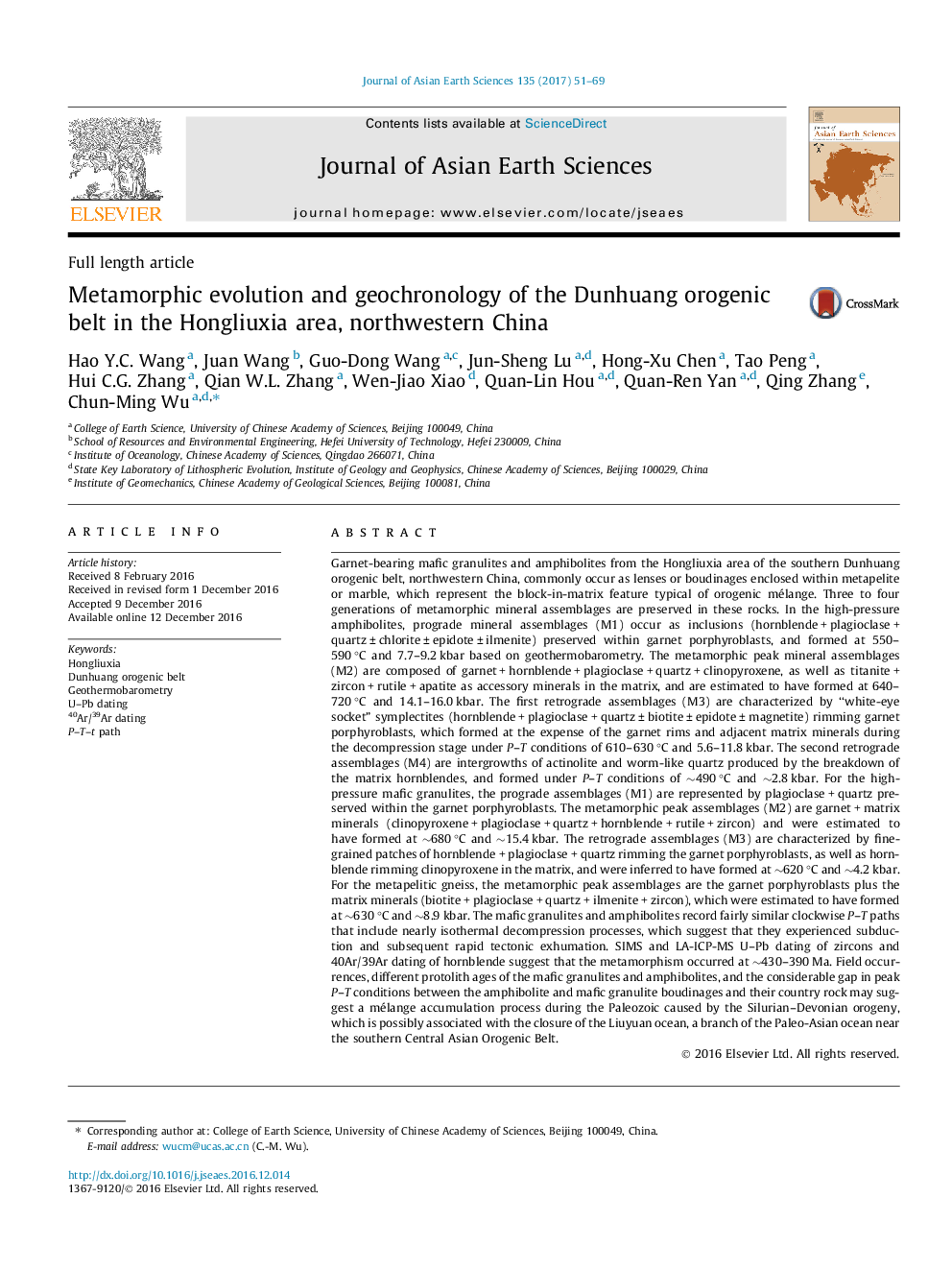| کد مقاله | کد نشریه | سال انتشار | مقاله انگلیسی | نسخه تمام متن |
|---|---|---|---|---|
| 5786102 | 1640336 | 2017 | 19 صفحه PDF | دانلود رایگان |

- Four stages of metamorphism have been recognized in the Hongliuxia block.
- Clockwise P-T paths were derived.
- The metamorphism occurred during 0.43-0.39Â Ga.
Garnet-bearing mafic granulites and amphibolites from the Hongliuxia area of the southern Dunhuang orogenic belt, northwestern China, commonly occur as lenses or boudinages enclosed within metapelite or marble, which represent the block-in-matrix feature typical of orogenic mélange. Three to four generations of metamorphic mineral assemblages are preserved in these rocks. In the high-pressure amphibolites, prograde mineral assemblages (M1) occur as inclusions (hornblende + plagioclase + quartz ± chlorite ± epidote ± ilmenite) preserved within garnet porphyroblasts, and formed at 550-590 °C and 7.7-9.2 kbar based on geothermobarometry. The metamorphic peak mineral assemblages (M2) are composed of garnet + hornblende + plagioclase + quartz + clinopyroxene, as well as titanite + zircon + rutile + apatite as accessory minerals in the matrix, and are estimated to have formed at 640-720 °C and 14.1-16.0 kbar. The first retrograde assemblages (M3) are characterized by “white-eye socket” symplectites (hornblende + plagioclase + quartz ± biotite ± epidote ± magnetite) rimming garnet porphyroblasts, which formed at the expense of the garnet rims and adjacent matrix minerals during the decompression stage under P-T conditions of 610-630 °C and 5.6-11.8 kbar. The second retrograde assemblages (M4) are intergrowths of actinolite and worm-like quartz produced by the breakdown of the matrix hornblendes, and formed under P-T conditions of â¼490 °C and â¼2.8 kbar. For the high-pressure mafic granulites, the prograde assemblages (M1) are represented by plagioclase + quartz preserved within the garnet porphyroblasts. The metamorphic peak assemblages (M2) are garnet + matrix minerals (clinopyroxene + plagioclase + quartz + hornblende + rutile + zircon) and were estimated to have formed at â¼680 °C and â¼15.4 kbar. The retrograde assemblages (M3) are characterized by fine-grained patches of hornblende + plagioclase + quartz rimming the garnet porphyroblasts, as well as hornblende rimming clinopyroxene in the matrix, and were inferred to have formed at â¼620 °C and â¼4.2 kbar. For the metapelitic gneiss, the metamorphic peak assemblages are the garnet porphyroblasts plus the matrix minerals (biotite + plagioclase + quartz + ilmenite + zircon), which were estimated to have formed at â¼630 °C and â¼8.9 kbar. The mafic granulites and amphibolites record fairly similar clockwise P-T paths that include nearly isothermal decompression processes, which suggest that they experienced subduction and subsequent rapid tectonic exhumation. SIMS and LA-ICP-MS U-Pb dating of zircons and 40Ar/39Ar dating of hornblende suggest that the metamorphism occurred at â¼430-390 Ma. Field occurrences, different protolith ages of the mafic granulites and amphibolites, and the considerable gap in peak P-T conditions between the amphibolite and mafic granulite boudinages and their country rock may suggest a mélange accumulation process during the Paleozoic caused by the Silurian-Devonian orogeny, which is possibly associated with the closure of the Liuyuan ocean, a branch of the Paleo-Asian ocean near the southern Central Asian Orogenic Belt.
99
Journal: Journal of Asian Earth Sciences - Volume 135, March 2017, Pages 51-69